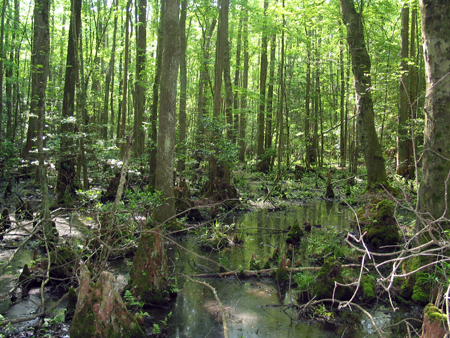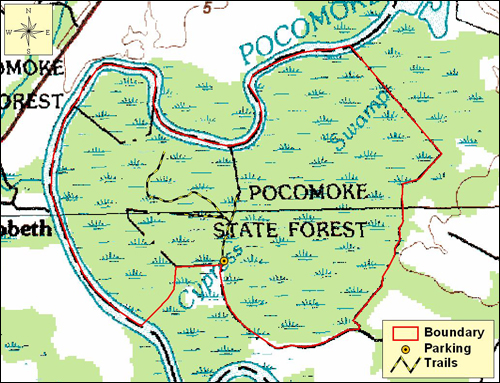Hickory Point Cypress Swamp, Worcester County
 From towering bald cypress trees to dry, upland forests, Hickory Point Cypress Swamp Natural Area is a wildly diverse ecosystem. This broad wetland is regarded by some as a northern extension of the Great Dismal Swamp in Virginia. The bald cypress trees that characterize the swamp are deciduous conifers, evergreen trees that lose their leaves each fall. Cypress trees can live for over 1,500 years and, as a species, they have survived for a very long time; they were common during the Jurassic period when dinosaurs roamed the earth. Much of Hickory Point is best explored by meandering up the tidal areas and through the swamp by kayak or canoe. While there is no maintained trail network, day hikers can use abandoned logging roads for access to the oak-pine and oak-heath forests found in the uplands.
From towering bald cypress trees to dry, upland forests, Hickory Point Cypress Swamp Natural Area is a wildly diverse ecosystem. This broad wetland is regarded by some as a northern extension of the Great Dismal Swamp in Virginia. The bald cypress trees that characterize the swamp are deciduous conifers, evergreen trees that lose their leaves each fall. Cypress trees can live for over 1,500 years and, as a species, they have survived for a very long time; they were common during the Jurassic period when dinosaurs roamed the earth. Much of Hickory Point is best explored by meandering up the tidal areas and through the swamp by kayak or canoe. While there is no maintained trail network, day hikers can use abandoned logging roads for access to the oak-pine and oak-heath forests found in the uplands.
Hickory Point Cypress Swamp encompasses over 2,000 acres which are owned and managed by the State of Maryland. Much of the biological diversity at this site can be attributed to the variety of habitats present, such as oak-loblolly pine forests, mixed oak-heath forests, tidal bald cypress forests, Atlantic white cedar (Chamaecyparis thyoides) swamps, and slightly brackish tidal shrublands and marshes. The extensive system is ideal habitat for forest interior dwelling species like the barred owl and black-and-white warbler, as well as species that thrive in ecotones, places where different habitats merge.

Swamps of Significance
Hickory Point Cypress Swamp is the largest southern swamp system in Maryland, and supports at least 14 rare, threatened and endangered species. In addition to the rare species, the Natural Area is a well known bald eagle roosting site. As many as 50 bald eagles can be seen here at one time! The dark swamp water also supports a variety of fish, such as perch, pickerel, catfish, herring, largemouth bass and the rare longnose gar (Lepisosteus osseus).

A Natural Partnership
Our largest population of the state-listed Endangered shrub red bay (Persea palustris) can be found at Hickory Point. Red bay is a larval host plant for the Palamedes swallowtail (Papilio palamedes), a butterfly which also is listed in Maryland as Endangered. Palamedes swallowtails are usually found near wetlands where the shrub grows. Larvae of the Palamedes swallowtail will only survive on species in the laurel plant family, such as red bay.
Click here for a Print Version of this map.

Special Note: The best access area for boat launch is near the town of Rehobeth in Somerset County. Hickory Point Cypress Swamp Natural Area is used seasonally by hunters.
Directions
From Pocomoke City: Cross the Pocomoke River heading south on US 13. At the junction of US 13 and US 113, turn right (west) onto Old Virginia Road/Pocomoke Beltway. Continue 1.9 miles to MD 371 (Cedar Hall Road). Stay straight and follow MD 317 for 2.8 miles. Turn right onto Hickory Point Road and travel another 2 miles (paved road becomes a dirt road). Follow the dirt road to a small parking area at the front of a gate (which blocks the remainder of the road) and park here.


Driving directions and aerial views open with Google Maps. For the aerial view button, if an aerial view does not open by default, click on the Satellite icon in the upper right corner and Google Maps will switch to an aerial view of the Natural Area.

Acknowledgments
Scenic View of Hickory Point Cypress Swamp Natural Area. Photo by: Jason Harrison
Wildlife Collage One: (left to right)
Rarities like this great purple hair-streak (Atlides halesus) can be found at Hickory Point. Its orange abdomen warns predators that it is highly distasteful. Photo by: Lynn Davidson
A stand of Atlantic white cedar towers over the swamp.. Photo by: Bill McAvoy
The once Endangered bald eagle is now a fairly common sight at Hickory Point. Look for these majestic birds along the Pocomoke River. Photo by: USFW
Wildlife Collage Two: (left to right)
Fluttering gracefully through the swamps, �a Palamedes swallowtail is a striking sight. �The dark brown wings, striped head and thorax distinguish this rare butterfly from the common male black swallowtail. Photo by: Vincent Lucas/Wikimedia Commons
The slow, murky waters at Hickory Point are perfect habitat for the longnose gar. Unlike most fish, gars can supplement their oxygen intake by gulping air above the water's surface. Photo by: Wikimedia Commons